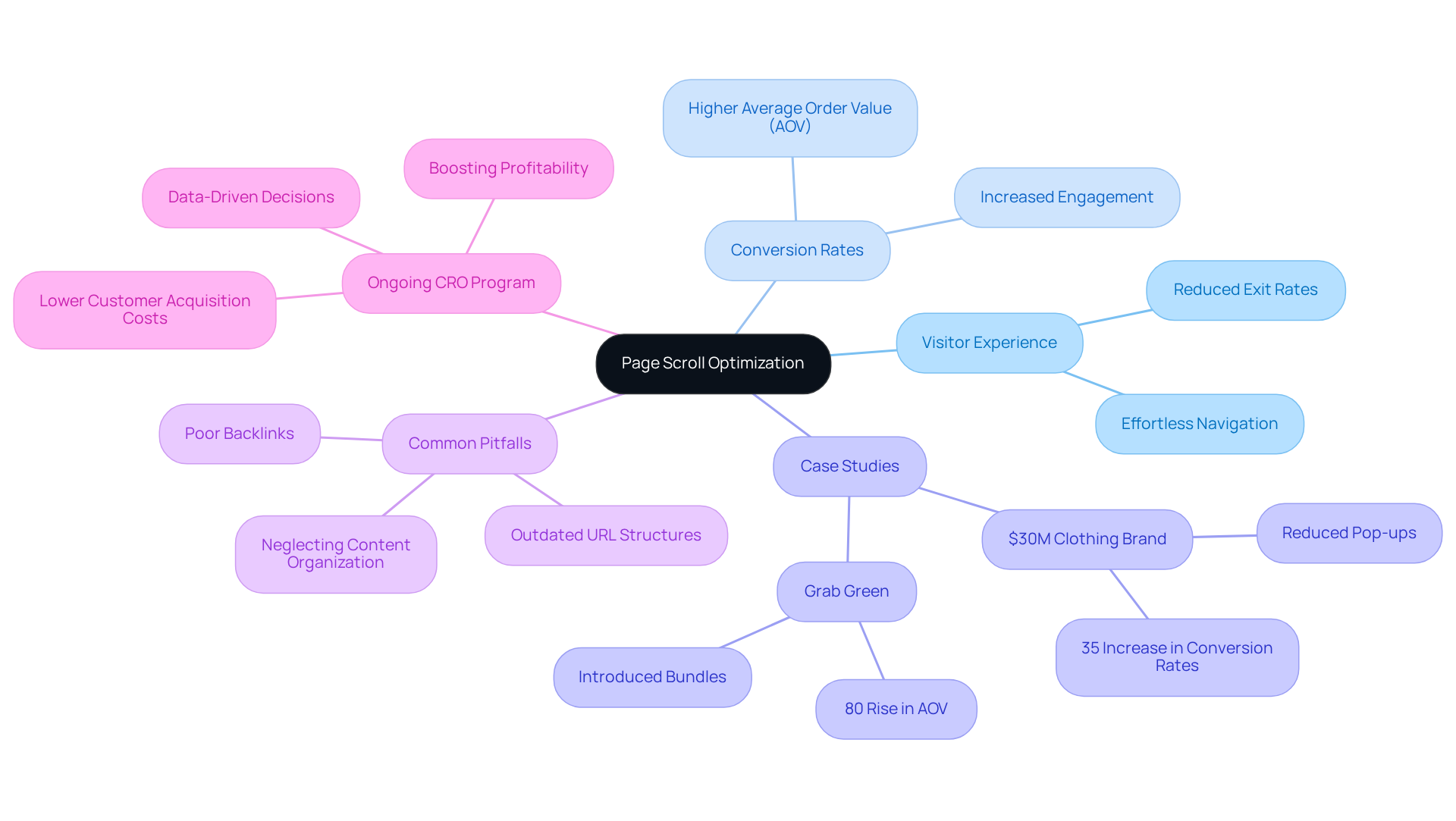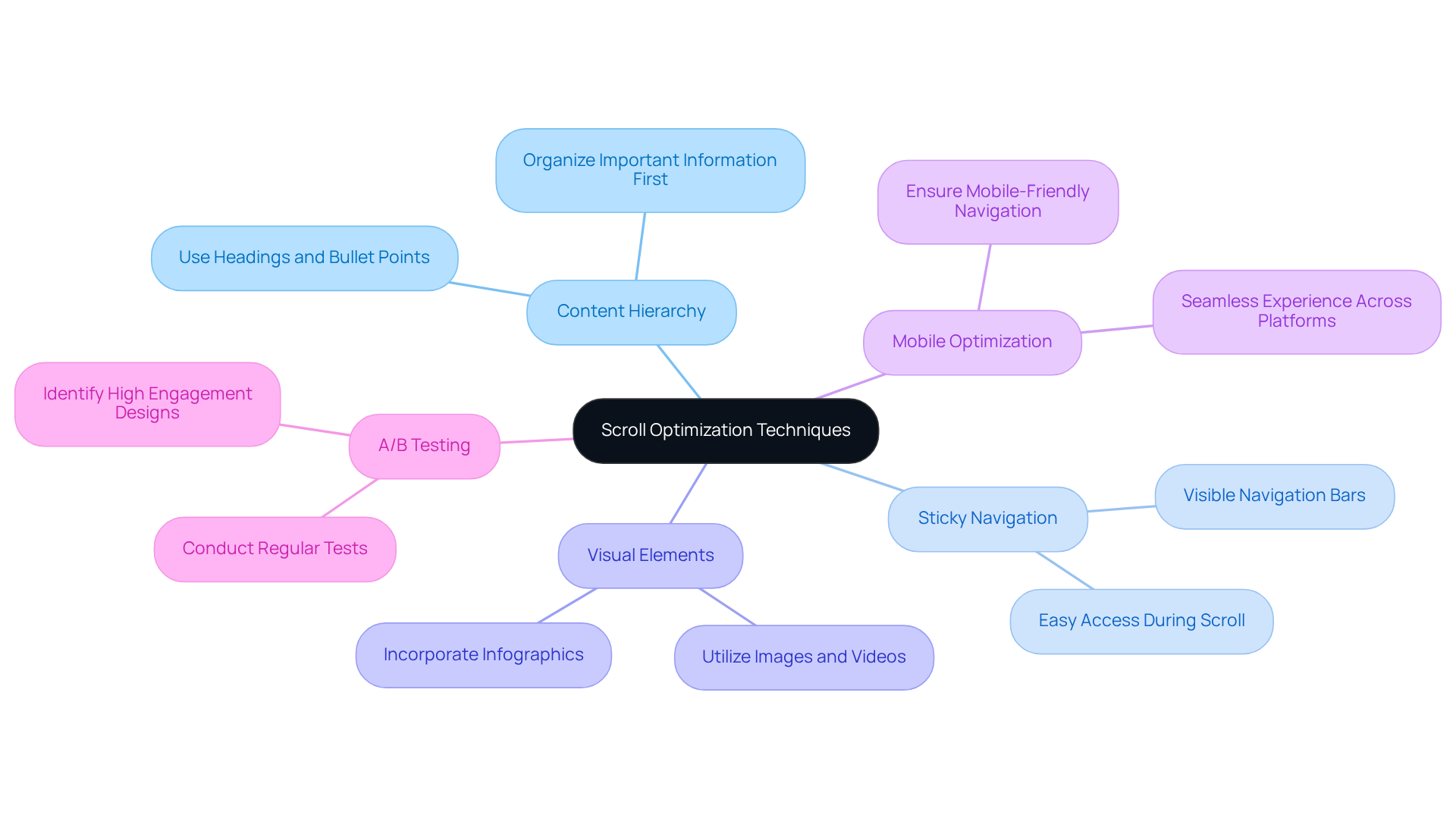
Overview
Effective page scroll optimization is crucial for enhancing user experience and maximizing conversions. By prioritizing content hierarchy, employing sticky navigation, and incorporating engaging visual elements, brands can significantly improve their scrolling experience.
-
First, prioritizing content hierarchy ensures that users encounter the most important information first, guiding them seamlessly through the page. This strategic arrangement not only captures attention but also keeps users engaged longer. For instance, brands that have implemented this practice report notable increases in visitor retention.
-
Next, sticky navigation plays a vital role in maintaining user focus. By keeping essential navigation options visible as users scroll, brands can reduce frustration and encourage exploration. This technique has proven effective for many successful companies, leading to higher conversion rates.
-
Lastly, incorporating visual elements enhances user engagement. Dynamic images, videos, and infographics can break up text and make content more digestible. Brands that leverage these elements often see a marked improvement in user interaction and satisfaction.
In conclusion, a well-optimized scrolling experience is not just about aesthetics; it’s about strategic content arrangement and continuous adjustments based on user data. By adopting these best practices, brands can create a compelling user journey that drives conversions and fosters loyalty.
Introduction
Effective page scroll optimization isn’t merely a technical necessity; it stands as a pivotal element in crafting a seamless user experience that drives engagement and conversions. As users navigate through content, the ease with which they can scroll significantly impacts their likelihood to remain on a site and ultimately make a purchase. This article explores best practices that empower brands to enhance their page scroll strategies, showcasing the tangible benefits of well-organized content and intuitive navigation.
However, what hidden challenges could derail these efforts? How can brands sidestep common pitfalls to ensure their optimization strategies resonate with users? By addressing these questions, we can uncover actionable insights that not only enhance user experience but also bolster conversion rates.
Understand the Importance of Page Scroll Optimization
Optimizing page scroll is essential for enhancing visitor experience and maximizing conversion rates. When users can navigate content effortlessly, they’re more likely to engage with it and ultimately convert. Research shows that users often abandon pages that require excessive page scroll or present content chaotically.
For instance, a $30M clothing brand partnered with Parah Group and saw a remarkable 35% increase in conversion rates after implementing strategic changes, such as reducing unnecessary pop-ups and refining their homepage design to enhance engagement. Similarly, Grab Green, a $15M cleaning product brand, tested free shipping thresholds and introduced bundles, leading to an impressive 80% rise in average order value (AOV). These examples underscore the power of strategic content arrangement and enhancement.
By ensuring that key information is readily accessible without overwhelming users, brands can significantly boost their chances of retaining visitors and converting them into customers. Furthermore, efficient page navigation can lead to lower exit rates and longer time spent on the site—both critical indicators of e-commerce success. Irini Saranti, Global Marketing Director at IYC, emphasizes the importance of strong search engine rankings, which are closely tied to engagement metrics. Companies that have successfully implemented strategies for page scroll enhancement report substantial improvements in user engagement and conversion rates, highlighting the tangible benefits of this approach.
However, it’s crucial to avoid common pitfalls, such as neglecting content organization or failing to address outdated URL structures and poor backlinks during website redesigns, to fully leverage the advantages of optimization. Additionally, maintaining an ongoing Conversion Rate Optimization (CRO) program enables data-driven decisions that directly contribute to business growth while lowering customer acquisition costs and boosting profitability.

Implement Effective Scroll Optimization Techniques
To effectively optimize page scroll, consider these essential techniques:
-
Prioritize Content Hierarchy: Organizing content to highlight the most important information first is crucial. Use headings, subheadings, and bullet points to break up text, making it scannable and easy to digest.
-
Employ sticky navigation by implementing navigation bars that remain visible during page scroll. This feature allows for easy access to other sections of the site, enhancing the browsing experience without interruptions.
-
Incorporate Visual Elements: Engaging users visually is key. Utilize images, videos, and infographics to convey information more effectively and maintain interest as users navigate through the content.
-
Optimize for Mobile: With a significant portion of traffic coming from mobile devices, ensure that your navigation enhancements are mobile-friendly. A seamless page scroll experience across all platforms is crucial for user satisfaction.
-
A/B Testing: Regularly conduct A/B tests on various page designs and content arrangements. This iterative approach helps identify which versions yield the highest engagement and conversion rates, allowing for ongoing enhancements based on user behavior.

Leverage User Data for Continuous Improvement
To ensure your page scroll optimization remains effective, it is essential to consistently leverage client data. Here are some strategies to consider:
-
Analyze Visitor Behavior: Tools like heatmaps and session recordings are invaluable for observing how users interact with your pages. This data reveals where visitors navigate, where they lose interest, and which sections capture the most attention. Platforms such as Hotjar and Crazy Egg simplify this process, allowing for efficient monitoring of user engagement.
-
Gather Feedback: Implementing customer surveys and feedback forms provides direct insights into users' scrolling experiences. Understanding their pain points enables you to make informed adjustments that enhance usability with respect to page scroll.
-
Monitor Key Metrics: Keep a close watch on metrics like scrolling depth, bounce rates, and conversion rates. A page scroll depth of 75% is generally regarded as favorable for long-form content. Regularly examining these metrics helps identify trends and areas for improvement.
-
Iterate Based on Discoveries: Use the insights gained from user data to make incremental adjustments to your engagement optimization strategies. Regularly refreshing your approach based on actual visitor interactions ensures your website remains audience-focused and effective in driving conversions.
-
Avoid Common Pitfalls: Be wary of relying solely on standard thresholds for scroll tracking, as this can lead to misleading conclusions about user engagement. Instead, customize your tracking to capture a more nuanced understanding of user behavior.

Conclusion
Optimizing page scroll is not just a detail; it’s a pivotal strategy for enhancing user experience and driving conversion rates. By streamlining navigation and presenting content in a well-organized manner, brands can significantly elevate how visitors interact with their websites. This optimization retains users longer and encourages deeper engagement, ultimately leading to higher conversion rates.
Several key techniques for effective scroll optimization stand out:
- Prioritizing content hierarchy ensures that users see the most important information first.
- Utilizing sticky navigation keeps essential links accessible.
- Incorporating visual elements maintains user interest.
- The importance of mobile optimization and A/B testing cannot be overstated; these practices ensure that every visitor enjoys a seamless browsing experience.
- Leveraging user data through behavior analysis and feedback collection supports continuous improvement, adapting strategies based on real-time insights.
In a digital landscape where user engagement reigns supreme, implementing effective page scroll optimization techniques is essential. Brands must recognize the value of a well-structured and visually appealing website that caters to user preferences. By committing to ongoing enhancements and utilizing data-driven strategies, businesses can not only boost their conversion rates but also foster lasting relationships with their customers. Embracing these best practices will ensure that websites remain competitive and user-friendly in an ever-evolving market.
Frequently Asked Questions
Why is page scroll optimization important?
Page scroll optimization is essential for enhancing visitor experience and maximizing conversion rates. It allows users to navigate content effortlessly, increasing the likelihood of engagement and conversion.
What impact can page scroll optimization have on conversion rates?
Research indicates that users often abandon pages requiring excessive scrolling or presenting chaotic content. For example, a clothing brand saw a 35% increase in conversion rates after optimizing their page layout.
Can you provide examples of brands that benefited from page scroll optimization?
Yes, a $30M clothing brand partnered with Parah Group and achieved a 35% increase in conversion rates. Similarly, Grab Green, a $15M cleaning product brand, tested free shipping thresholds and introduced bundles, resulting in an 80% rise in average order value.
How does efficient page navigation affect user engagement?
Efficient page navigation can lead to lower exit rates and longer time spent on the site, both of which are critical indicators of e-commerce success and user engagement.
What role do search engine rankings play in page scroll optimization?
Strong search engine rankings are closely tied to engagement metrics. Companies that enhance their page scroll report substantial improvements in both user engagement and conversion rates.
What common pitfalls should be avoided during website redesigns?
Common pitfalls include neglecting content organization, failing to address outdated URL structures, and not fixing poor backlinks, all of which can hinder the advantages of optimization.
How can businesses maintain the benefits of page scroll optimization over time?
Maintaining an ongoing Conversion Rate Optimization (CRO) program enables businesses to make data-driven decisions that contribute to growth, lower customer acquisition costs, and boost profitability.
FAQs











